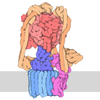[English] 日本語
 Yorodumi
Yorodumi- PDB-6t8h: Cryo-EM structure of the DNA-bound PolD-PCNA processive complex f... -
+ Open data
Open data
- Basic information
Basic information
| Entry | Database: PDB / ID: 6t8h | |||||||||||||||||||||||||||||||||||||||||||||||||||||||||||||||||||||||||||||||||||||||||||||||||||||||||
|---|---|---|---|---|---|---|---|---|---|---|---|---|---|---|---|---|---|---|---|---|---|---|---|---|---|---|---|---|---|---|---|---|---|---|---|---|---|---|---|---|---|---|---|---|---|---|---|---|---|---|---|---|---|---|---|---|---|---|---|---|---|---|---|---|---|---|---|---|---|---|---|---|---|---|---|---|---|---|---|---|---|---|---|---|---|---|---|---|---|---|---|---|---|---|---|---|---|---|---|---|---|---|---|---|---|---|
| Title | Cryo-EM structure of the DNA-bound PolD-PCNA processive complex from P. abyssi | |||||||||||||||||||||||||||||||||||||||||||||||||||||||||||||||||||||||||||||||||||||||||||||||||||||||||
 Components Components |
| |||||||||||||||||||||||||||||||||||||||||||||||||||||||||||||||||||||||||||||||||||||||||||||||||||||||||
 Keywords Keywords | REPLICATION / PCNA / DP2 / PolD / DP1 / PIP-box | |||||||||||||||||||||||||||||||||||||||||||||||||||||||||||||||||||||||||||||||||||||||||||||||||||||||||
| Function / homology |  Function and homology information Function and homology informationexodeoxyribonuclease I / DNA polymerase complex / intein-mediated protein splicing / single-stranded DNA 3'-5' DNA exonuclease activity / DNA catabolic process / DNA strand elongation involved in DNA replication / DNA polymerase processivity factor activity / leading strand elongation / regulation of DNA replication / DNA-templated DNA replication ...exodeoxyribonuclease I / DNA polymerase complex / intein-mediated protein splicing / single-stranded DNA 3'-5' DNA exonuclease activity / DNA catabolic process / DNA strand elongation involved in DNA replication / DNA polymerase processivity factor activity / leading strand elongation / regulation of DNA replication / DNA-templated DNA replication / DNA-directed DNA polymerase / DNA-directed DNA polymerase activity / DNA binding Similarity search - Function | |||||||||||||||||||||||||||||||||||||||||||||||||||||||||||||||||||||||||||||||||||||||||||||||||||||||||
| Biological species |   Pyrococcus abyssi (archaea) Pyrococcus abyssi (archaea)synthetic construct (others) | |||||||||||||||||||||||||||||||||||||||||||||||||||||||||||||||||||||||||||||||||||||||||||||||||||||||||
| Method | ELECTRON MICROSCOPY / single particle reconstruction / cryo EM / Resolution: 3.77 Å | |||||||||||||||||||||||||||||||||||||||||||||||||||||||||||||||||||||||||||||||||||||||||||||||||||||||||
 Authors Authors | Madru, C. / Raia, P. / Hugonneau Beaufet, I. / Pehau-Arnaudet, G. / England, P. / Lindhal, E. / Delarue, M. / Carroni, M. / Sauguet, L. | |||||||||||||||||||||||||||||||||||||||||||||||||||||||||||||||||||||||||||||||||||||||||||||||||||||||||
| Funding support |  France, France,  Sweden, 3items Sweden, 3items
| |||||||||||||||||||||||||||||||||||||||||||||||||||||||||||||||||||||||||||||||||||||||||||||||||||||||||
 Citation Citation |  Journal: Nat Commun / Year: 2020 Journal: Nat Commun / Year: 2020Title: Structural basis for the increased processivity of D-family DNA polymerases in complex with PCNA. Authors: Clément Madru / Ghislaine Henneke / Pierre Raia / Inès Hugonneau-Beaufet / Gérard Pehau-Arnaudet / Patrick England / Erik Lindahl / Marc Delarue / Marta Carroni / Ludovic Sauguet /   Abstract: Replicative DNA polymerases (DNAPs) have evolved the ability to copy the genome with high processivity and fidelity. In Eukarya and Archaea, the processivity of replicative DNAPs is greatly enhanced ...Replicative DNA polymerases (DNAPs) have evolved the ability to copy the genome with high processivity and fidelity. In Eukarya and Archaea, the processivity of replicative DNAPs is greatly enhanced by its binding to the proliferative cell nuclear antigen (PCNA) that encircles the DNA. We determined the cryo-EM structure of the DNA-bound PolD-PCNA complex from Pyrococcus abyssi at 3.77 Å. Using an integrative structural biology approach - combining cryo-EM, X-ray crystallography, protein-protein interaction measurements, and activity assays - we describe the molecular basis for the interaction and cooperativity between a replicative DNAP and PCNA. PolD recruits PCNA via a complex mechanism, which requires two different PIP-boxes. We infer that the second PIP-box, which is shared with the eukaryotic Polα replicative DNAP, plays a dual role in binding either PCNA or primase, and could be a master switch between an initiation and a processive phase during replication. | |||||||||||||||||||||||||||||||||||||||||||||||||||||||||||||||||||||||||||||||||||||||||||||||||||||||||
| History |
|
- Structure visualization
Structure visualization
| Movie |
 Movie viewer Movie viewer |
|---|---|
| Structure viewer | Molecule:  Molmil Molmil Jmol/JSmol Jmol/JSmol |
- Downloads & links
Downloads & links
- Download
Download
| PDBx/mmCIF format |  6t8h.cif.gz 6t8h.cif.gz | 454.3 KB | Display |  PDBx/mmCIF format PDBx/mmCIF format |
|---|---|---|---|---|
| PDB format |  pdb6t8h.ent.gz pdb6t8h.ent.gz | 353.5 KB | Display |  PDB format PDB format |
| PDBx/mmJSON format |  6t8h.json.gz 6t8h.json.gz | Tree view |  PDBx/mmJSON format PDBx/mmJSON format | |
| Others |  Other downloads Other downloads |
-Validation report
| Summary document |  6t8h_validation.pdf.gz 6t8h_validation.pdf.gz | 1.3 MB | Display |  wwPDB validaton report wwPDB validaton report |
|---|---|---|---|---|
| Full document |  6t8h_full_validation.pdf.gz 6t8h_full_validation.pdf.gz | 1.4 MB | Display | |
| Data in XML |  6t8h_validation.xml.gz 6t8h_validation.xml.gz | 92.5 KB | Display | |
| Data in CIF |  6t8h_validation.cif.gz 6t8h_validation.cif.gz | 137.5 KB | Display | |
| Arichive directory |  https://data.pdbj.org/pub/pdb/validation_reports/t8/6t8h https://data.pdbj.org/pub/pdb/validation_reports/t8/6t8h ftp://data.pdbj.org/pub/pdb/validation_reports/t8/6t8h ftp://data.pdbj.org/pub/pdb/validation_reports/t8/6t8h | HTTPS FTP |
-Related structure data
| Related structure data |  10401MC 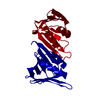 6t7xC 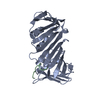 6t7yC M: map data used to model this data C: citing same article ( |
|---|---|
| Similar structure data |
- Links
Links
- Assembly
Assembly
| Deposited unit | 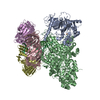
|
|---|---|
| 1 |
|
- Components
Components
-DNA polymerase ... , 2 types, 4 molecules ECDA
| #1: Protein | Mass: 29471.764 Da / Num. of mol.: 3 Source method: isolated from a genetically manipulated source Source: (gene. exp.)   Pyrococcus abyssi (strain GE5 / Orsay) (archaea) Pyrococcus abyssi (strain GE5 / Orsay) (archaea)Strain: GE5 / Orsay / Gene: pcn, PYRAB13790, PAB1465 / Production host:  #2: Protein | | Mass: 69408.008 Da / Num. of mol.: 1 / Mutation: H451A Source method: isolated from a genetically manipulated source Source: (gene. exp.)   Pyrococcus abyssi (strain GE5 / Orsay) (archaea) Pyrococcus abyssi (strain GE5 / Orsay) (archaea)Strain: GE5 / Orsay / Gene: polB, PYRAB01210, PAB2266 / Production host:  References: UniProt: Q9V2F3, DNA-directed DNA polymerase, exodeoxyribonuclease I |
|---|
-Protein , 1 types, 1 molecules B
| #3: Protein | Mass: 144762.188 Da / Num. of mol.: 1 Source method: isolated from a genetically manipulated source Source: (gene. exp.)   Pyrococcus abyssi (archaea) / Production host: Pyrococcus abyssi (archaea) / Production host:  References: UniProt: Q9V2F4*PLUS, DNA-directed DNA polymerase |
|---|
-DNA chain , 2 types, 2 molecules PT
| #4: DNA chain | Mass: 5519.542 Da / Num. of mol.: 1 / Source method: obtained synthetically / Source: (synth.) synthetic construct (others) |
|---|---|
| #5: DNA chain | Mass: 7717.934 Da / Num. of mol.: 1 / Source method: obtained synthetically / Source: (synth.) synthetic construct (others) |
-Non-polymers , 2 types, 5 molecules 


| #6: Chemical | ChemComp-FE / |
|---|---|
| #7: Chemical | ChemComp-ZN / |
-Details
| Has ligand of interest | N |
|---|---|
| Has protein modification | Y |
-Experimental details
-Experiment
| Experiment | Method: ELECTRON MICROSCOPY |
|---|---|
| EM experiment | Aggregation state: PARTICLE / 3D reconstruction method: single particle reconstruction |
- Sample preparation
Sample preparation
| Component |
| ||||||||||||||||||||||||
|---|---|---|---|---|---|---|---|---|---|---|---|---|---|---|---|---|---|---|---|---|---|---|---|---|---|
| Molecular weight | Value: 310 kDa/nm / Experimental value: YES | ||||||||||||||||||||||||
| Source (natural) |
| ||||||||||||||||||||||||
| Source (recombinant) |
| ||||||||||||||||||||||||
| Buffer solution | pH: 8 | ||||||||||||||||||||||||
| Specimen | Conc.: 0.1 mg/ml / Embedding applied: NO / Shadowing applied: NO / Staining applied: NO / Vitrification applied: YES | ||||||||||||||||||||||||
| Specimen support | Details: 5mA current / Grid material: COPPER / Grid mesh size: 400 divisions/in. / Grid type: C-flat-2/2 4C | ||||||||||||||||||||||||
| Vitrification | Instrument: FEI VITROBOT MARK IV / Cryogen name: ETHANE / Humidity: 100 % / Chamber temperature: 293 K |
- Electron microscopy imaging
Electron microscopy imaging
| Experimental equipment |  Model: Titan Krios / Image courtesy: FEI Company |
|---|---|
| Microscopy | Model: FEI TITAN KRIOS |
| Electron gun | Electron source:  FIELD EMISSION GUN / Accelerating voltage: 300 kV / Illumination mode: FLOOD BEAM FIELD EMISSION GUN / Accelerating voltage: 300 kV / Illumination mode: FLOOD BEAM |
| Electron lens | Mode: BRIGHT FIELD / Nominal defocus min: 500 nm / Calibrated defocus max: 3500 nm / Cs: 2.7 mm / C2 aperture diameter: 70 µm / Alignment procedure: COMA FREE |
| Specimen holder | Cryogen: NITROGEN / Specimen holder model: FEI TITAN KRIOS AUTOGRID HOLDER |
| Image recording | Average exposure time: 5 sec. / Electron dose: 40 e/Å2 / Detector mode: COUNTING / Film or detector model: GATAN K2 QUANTUM (4k x 4k) / Num. of grids imaged: 1 / Num. of real images: 4602 |
| EM imaging optics | Energyfilter name: GIF Bioquantum / Energyfilter slit width: 20 eV |
| Image scans | Movie frames/image: 40 / Used frames/image: 1-40 |
- Processing
Processing
| EM software |
| ||||||||||||||||||||
|---|---|---|---|---|---|---|---|---|---|---|---|---|---|---|---|---|---|---|---|---|---|
| CTF correction | Type: PHASE FLIPPING AND AMPLITUDE CORRECTION | ||||||||||||||||||||
| Particle selection | Details: Indicated in the M&M | ||||||||||||||||||||
| Symmetry | Point symmetry: C1 (asymmetric) | ||||||||||||||||||||
| 3D reconstruction | Resolution: 3.77 Å / Resolution method: FSC 0.143 CUT-OFF / Num. of particles: 149200 / Symmetry type: POINT |
 Movie
Movie Controller
Controller



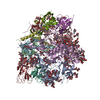

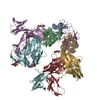
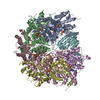

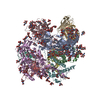
 PDBj
PDBj





































